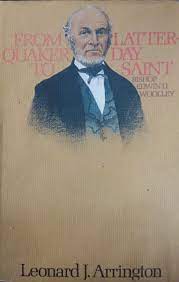Articles/Essays – Volume 11, No. 1
It Bears the Arrington Hallmark | Leonard J. Arrington, From Quaker to Latter-day Saint: Bishop Edwin D. Woolley
From Quaker to Latter-day Saint is an unfortunate title. Neither interesting nor particularly descriptive, it combines with the design and size of the volume to suggest one of those wearying biographies of a minor figure primped and corsetted with reams of family “begats” into the role of someone major.
Unfortunate indeed. Whoever is willing to look beyond the cover will be well rewarded. Edwin D. Woolley was one of those solid, prosaic nineteenth-century Mormon businessmen and long-time bishops trusted and valued by Joseph Smith and Brigham Young alike. Because of this, Quaker is more than a biography; it is also a good look at the church’s formative years. And bearing the Arrington hallmark, it is filled with engaging anecdotes, colorful details, strong descriptive writing and plenty of good humor. Few historians are as gifted as Leonard Arrington in coaxing the best from his sources. If young Ed win’s diary contains no interesting material about his trip from Pennsylvania to the Ohio River Valley in 1830, Dr. Arrington turns to diaries of other travelers for tidbits of adventure on those frontier thoroughfares. If the eulogizing becomes a bit heavy or the meetings get a little stuffy, the reader is suddenly refreshed by the simple eloquence of the Indian in testimony meeting: “Mormon tick-a-boo [friend]. White man, son of a bitch.” Light verse and nonsense gleaned from the Expositor and Woolley’s journal, a poetic repartee from W. W. Phelps and Parley P. Pratt on the challenge of polygamous living, doggerel rhyme from Carson Valley about Mormon girls—these and many other light touches beckon the reader and keep the narrative lively.
Ironically, the one obvious deficiency in the makeup of the book relates to the very matter of readability. Throughout, Quaker is burdened by long direct quotes, few of which are as interesting as an Arrington paraphrase would have been. They also add needless bulk to the book. Less bothersome, but begging mention in this regard, is the matter of too much detail and some repetition. In places the book simply lacks discipline. Chapter 12, for example, will fairly smother the reader with day-to-day comings and goings, including an account of an overland journey east ward that is a virtual mirror image of the west ward account given in chapter 10.
But however viewed, this book is packed with good history. The account of early home building, homemaking, and farming in the Salt Lake Valley is especially good. The dynamics of a barter economy and the administration of the early public works program in Utah are also discussed here with insight and understanding. Those who seek a good capsule summary of the Utah Expedition, the Godbeite schism, or the duties of a ninereenth-century Mormon bishop will find all that and much more in this busy book.
It is true, leading bits of obiter dicta have crept into the manuscript here and there (“Edwin had committed himself to Mormonism, and, like many another strong-minded man, he enthusiastically submerged his will to the vision of the thirty-four-year-old prophet”) but Quaker is generally free of didacticism. Indeed, such indelicate matters as the growing irascibility of Brigham Young, the turbulance of polygamy and the strange excesses of the Reformation (Jedediah Grant “threatened to send the police around to wash the bishops if they wouldn’t do it themselves”) are discussed as a matter of course. For anyone who prefers his history without the golden questions, here, for the remarkable price of $6.95, is a golden opportunity.
From Quaker to Latter-day Saint: Bishop Edwin D. Woolley. By Leonard J. Arrington. Salt Lake City: Deseret Book Company, 1976. xiv + 592 pp, $6.95.


 Back to full Issue
Back to full Issue

